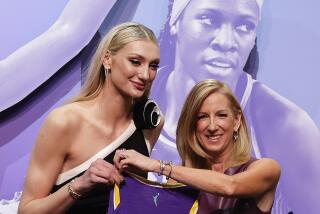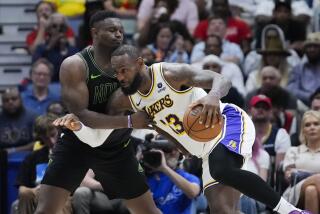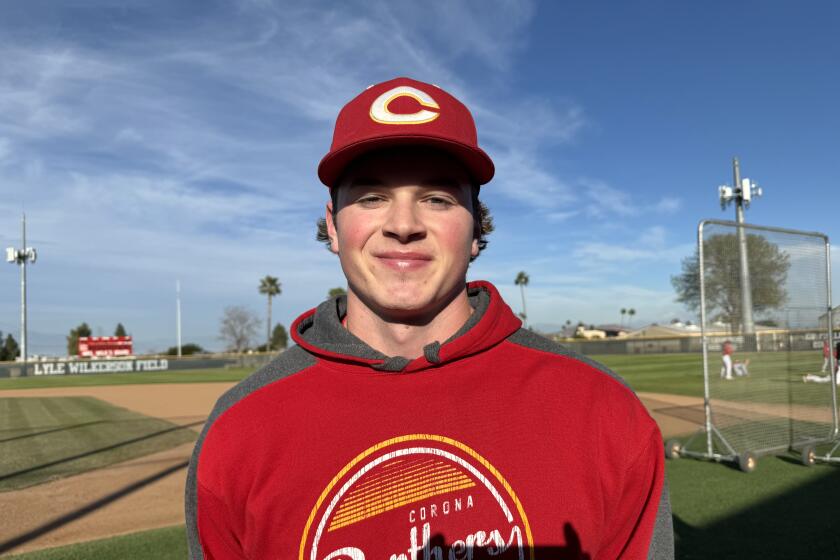Today, helmets for all
COLLEGE track star Kevin Dare shook the track and field world four years ago when he attempted to pole-vault 15 feet, 7 inches during a Big 10 track meet in Minnesota.
The vault was no record attempt. It was not even Dare’s personal best. The jump was sadly unforgettable because Dare missed and was killed when he landed head first in the steel takeoff box that vaulters use to catapult themselves into the air.
After years of debate on ways to make the sport safer, a standards panel approved in May the first specifications for a pole vaulting helmet, spurring production of several models.
In the last few years, that same panel, the American Society for Testing and Materials, has approved headgear standards for martial arts, short-track speed skating, horseback riding, bull riding and soccer -- a total of 13 helmets since 2000.
This is in addition to headgear already on the market for bicycling, motorcycle riding, in-line skating, skiing, baseball and football. Call it the “helmetization” of America. And blame it on an increasingly safety-conscious world in which nearly every sport or recreational activity that poses a head-injury threat -- even a minor one -- is sized up for a helmet.
Head injury experts worry that some new helmets have come on the market without empirical data to show the need for or the effectiveness of the headgear.
“There is limited data for some of these kinds of sports,” said Dr. Frederick P. Rivara, a pediatrics professor at the University of Washington School of Medicine who has studied helmet use among youngsters. “Before we push these kinds of helmets we need to have an idea on the effectiveness.”
Dr. Tony Strickland, director of the Sports Concussion Institute at the Centinela Freeman Regional Medical Center in Marina del Rey, shares the same concerns, adding that poorly designed helmets could interfere with an athlete’s hearing and vision.
“Some might argue that some protection is better than none,” he says. “That’s not always the case.”
America’s helmet movement began 20 years ago when states and local governments started adopting bicycle helmet laws targeting teenage riders. It was prompted by a national campaign led by parents and doctors and fueled by a New England Journal of Medicine study that said 85% of bicycle head injuries could be prevented by wearing a helmet.
Although bicycle helmet use has varied by state, surveys show the helmets are effective when worn. In California, severe head injuries among youths 17 and younger has dropped 18% since the state in 1994 began requiring them to wear helmets, according to a 2005 study by the University of Washington and Northwestern University.
The same might not be said of other helmets. In recent years, the development of new headgear has been pushed less by the number of injuries and more by emotion-filled campaigns led by advocacy groups, in most cases, headed by the parents of injured youngsters. Pole vaulting, for example, has new helmet standards -- but did not experience a preceding sharp spike in head injuries.
“It starts with an individual with a story,” said Susan Connor, president of the Brain Injury Assn., a Washington, D.C.-based group that represents more than 5 million brain injury victims, families and professionals. “It’s not ideal, but that is the normal course of events.”
The American Society for Testing and Materials -- one of four panels that approves helmet standards in the country -- has been reviewing dozens of requests for new helmet standards in the last few years.
Because athletic associations and government agencies usually don’t require helmets until a standard is set for thickness, shape, material and design, a campaign to mandate helmets for a sport often starts by persuading a testing agency to set a standard. Thus, the four panels are the target of heavy lobbying by helmet manufacturers and the parents of injured athletes.
The agencies’ willingness to consider new gear may also reflect the public’s growing acceptance of helmets. In 2002, Americans bought 2.4 million helmets for all sports. By 2004, that number had jumped to 4.7 million, according to Board-Trac, an Orange County-based sports market research firm.
Randy Swart, vice chairman of ASTM’s headgear subcommittee, said his group typically wouldn’t consider adopting a helmet standard until a group of athletes, schools or parents made a push for such a standard. A jump in reported head injuries alone won’t prompt action from his group, he said.
As an example, he pointed out that basketball has one of the highest rates of head injuries of any sport but that his subcommittee has not considered standards for a basketball helmet because no one has lobbied for it.
“If the people in the sport are not interested, then there is no point to make headgear,” he said.
So new helmets are typically created through a movement by the people in a particular sport -- some of whom have not just an emotional interest, but a financial one as well.
Perhaps, pediatrics professor Rivara says, new helmets should be developed based on recommendations by the Centers for Disease Control and Prevention or the U.S. Consumer Product Safety Commission.
Athletes and standards
In the case of the pole vaulting helmet, Dare’s father, Edward Dare, and his former Penn State coach, Tim Curley, launched a four-year campaign to improve pole-vaulting landing pads and require helmets.
Soon after the accident, Minnesota, Wisconsin, Michigan and New York joined North Dakota and South Dakota in requiring helmets for high school pole-vaulters. But there were no helmet standards -- and consequently no helmets specifically for pole vaulting -- until this year, so many high school pole-vaulters wore hockey or skateboarding helmets.
After Dare’s death in 2002, the National Collegiate Athletic Assn. mandated larger landing pads but did not mandate helmets. The NCAA allows vaulters to wear helmets, but only on a voluntary basis.
Pole vaulting ranks far below most other sports in total head injuries. In 2001, the American Journal of Sports Medicine published a study that found 31 catastrophic head injuries associated with pole vaulting in the high school, college and amateur ranks between 1982 and 1998. Those accidents resulted in 16 deaths, according to the study.
The study did not compare pole vaulting injuries with other sports, but a Consumer Product Safety Commission study found that head injury incidents for pole-vaulters were relatively rare compared with other sports such as basketball (23,908), baseball (20,583) and football (20,128) in 1995 alone.
One of the authors of the 2001 pole vaulting study, 1972 Olympic pole vaulting bronze medalist, Jan Johnson, has been highly critical of the helmets. Johnson, who heads the pole vault safety committee for U.S. Track and Field, the governing body for high school track and field, said there has only been one catastrophic head injury since larger landing pads were adopted in 2002. “I think the problem was solved that way,” he said.
Although the study did not investigate the pros and cons of a pole vault helmet, Johnson says he worries that they may cause spinal injuries by hyper-flexing a vaulter’s neck on impact with the padding. “I am not a real strong advocate for helmets in pole vaulting,” he said.
Even the ASTM, while considering a pole vaulting helmet, warned that such headgear would not eliminate the risk of head injuries altogether.
But Dare’s father continues to press the NCAA and the National Federation of State High School Assns. to require helmets for all pole-vaulters.
Dare said there was no evidence that the helmets cause neck injuries. As for Johnson’s suggestion that the larger padding has solved the problem, Dare said: “Tell that to the next parents whose son or daughter vaults and hits their head on the asphalt and dies.”
It was that kind of parental fear that gave birth to the surfing helmet.
Twenty years ago, Western Australia state surfing champion Ric Gath came up with a design for a surfing helmet after watching his son, Jesse, narrowly escape being hit by a surfboard in a shallow beach break.
Gath Sports is now the world’s leading manufacturer of surf helmets, but only a handful of competitive surfers wear headgear in the water.
In 1998, medical researchers at Brown University School of Medicine, Rhode Island Hospital and the Hawaii State Department of Health conducted an Internet survey of 451 surfers and found that 35% of acute surfing injuries were to the head and neck. But only 9% of those surveyed wore helmets.
Gath insists that surf helmets are needed today more than ever as surfing spots become more crowded and surfers take on more treacherous waves near shallow reefs.
Eric Savitsky, a surfer and associate professor of emergency medicine at UCLA, said surf helmets could protect against blows from wayward surfboards. But he said helmets could also detract from the surfing experience, which is why he says most surfers don’t wear them.
The ASTM is now considering standards for surfing and whitewater helmets.
Gath’s story mirrors the tale of Jeff Skeen, a helmet manufacturer from La Jolla.
After witnessing his teenage daughter suffer a third concussion while playing soccer, Skeen developed a padded headband in 2002 that he believes can absorb blows from other players, the ground or a goal post.
The soccer headgear covers the crown of a player’s head, not the top.
But when Skeen insisted his daughter wear the headband at a soccer match, he said the referee prohibited her from playing with it on. That’s when he launched his campaign for mandatory soccer headgear and started Full90 Sports Inc., a San Diego-based soccer headgear firm.
Though health studies show that head injuries for pole vaulting and surfing are relatively rare, reports find that such injuries are a growing problem in soccer. A Consumer Product Safety Commission study found that soccer contributed to an estimated 14,465 head injuries that were treated in U.S. hospital emergency rooms in 2004. That is up from 9,269 head injuries in a similar study in 1995.
For several years, the issue of soccer headgear was clouded by concerns that heading the ball could also cause head injuries. But recent studies by the University of North Carolina, Chapel Hill and the University of Pennsylvania found no link between brain injuries and routine ball heading.
Once the focus turned to preventing accidental head collisions between players, the ground and the goal posts, soccer organizations softened their position on headgear.
Last January, the U.S. Soccer Federation, the governing body for soccer in the country, said the federation’s medical committee had found “no evidence that wearing of this sort of headgear is beneficial to players, and is concerned that it might actually lead to more injuries.”
But in August, the same federation released another statement, saying soccer headgear provides a “measurable benefit” in head-to-head impacts. The statement added: “There are still many unanswered questions -- most importantly, the extent to which this sort of headgear diminishes the risk of concussions, if at all.”
The U.S. Soccer Federation and the American Youth Soccer Organization permit players to wear headgear at their own discretion.
Rick Davis, AYSO’s national director of programs, said the youth soccer league was concerned about head injuries. But he said the league must first see conclusive evidence that soccer headgear prevents head injuries before it can consider making headgear mandatory.
He said some critics believed headgear could give players a false sense of invincibility.
“It may be a matter of time before some conclusive study or information comes forward that says, much like shinguards, headgear provides some form of protection,” he said.
*
(BEGIN TEXT OF INFOBOX)
A heads-up on activities with the most injuries
Cycling topped the list of sports and recreational activities with the most head injuries in 2004, the latest year for which data were available. The rankings, based on the estimated number of people treated in U.S. hospital emergency rooms, are:
* Cycling: 69,476
* Powered recreational vehicles (ATVs, dune buggies, off-road motorcycles): 27,213
* Football: 25,515
* Basketball: 24,320
* Baseball and softball: 22,671
* Water sports (diving, surfing, swimming, water-skiing): 18,860
* Winter sports (skiing, sledding, snowboarding): 18,566
* Skateboarding, scooters: 15,125
* Soccer: 14,465
* Horseback riding: 10,669
* Health club (exercise, weightlifting): 9,901
* Golf: 8,049
* Trampoline: 5,392
* Hockey: 4,741
* Ball sports (unspecified): 4,221
* Skating (in-line, roller, roller hockey): 4,041
* Ice skating: 2,852
* Fishing: 2,689
* Wrestling: 2,268
* Volleyball: 2,021
Source: U.S. Consumer Product Safety Commission
More to Read
Get our high school sports newsletter
Prep Rally is devoted to the SoCal high school sports experience, bringing you scores, stories and a behind-the-scenes look at what makes prep sports so popular.
You may occasionally receive promotional content from the Los Angeles Times.







